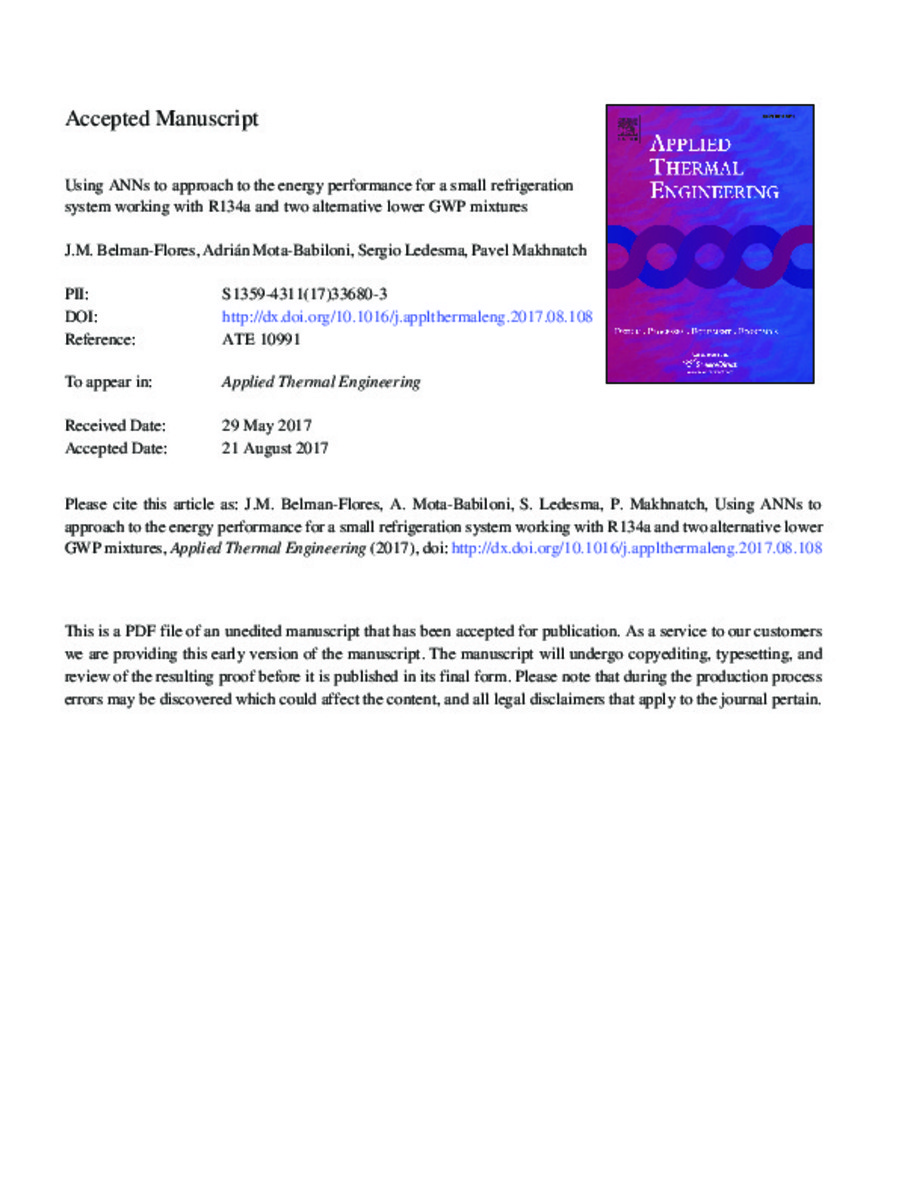Mostrar el registro sencillo del ítem
Using ANNs to approach to the energy performance for a small refrigeration system working with R134a and two alternative lower GWP mixtures
| dc.contributor.author | Belman, Juan | |
| dc.contributor.author | Mota-Babiloni, Adrián | |
| dc.contributor.author | Ledesma, Sergio | |
| dc.contributor.author | Makhnatch, Pavel | |
| dc.date.accessioned | 2018-02-01T11:29:25Z | |
| dc.date.available | 2018-02-01T11:29:25Z | |
| dc.date.issued | 2017 | |
| dc.identifier.citation | BELMAN-FLORES, J. M., et al. Using ANNs to approach to the energy performance for a small refrigeration system working with R134a and two alternative lower GWP mixtures. Applied Thermal Engineering, 2017, vol. 127, p. 996-1004. | ca_CA |
| dc.identifier.issn | 1359-4311 | |
| dc.identifier.uri | http://hdl.handle.net/10234/172539 | |
| dc.description.abstract | In this paper, an artificial neural network application to model a small refrigeration system is presented. The main objective of this study is an energy comparison of three refrigerants: R134a, R450A and R513A. The application of the artificial neural network was designed to model individually three typical energy parameters: the cooling capacity, the power consumption and the coefficient of performance, as a function of the evaporating temperature and the condensing temperature. Each model was validated using a technique called cross-validation, producing minimum relative errors of for the cooling capacity and the coefficient of performance, while 0.05 for the power consumption. Based on the appropriate validation results, computer simulations were performed to build 3D color surfaces. After inspecting these 3D color surfaces, it was concluded that R450A presented a slightly lower cooling capacity than R134a, actually a 10% reduction in the cooling capacity was estimated. Similar results were observed for the power consumption, that is, R450A had about 10% less power consumption than the other two refrigerants. On the other hand, it was observed that R134a and R513A presented very similar energy behaviors. With respect the COP, it was concluded that all three refrigerants showed a very similar behavior. After the analysis performed with the artificial neural networks and the use of 3D surface color, it was concluded that R450A and R513A are appropriate refrigerants to replace R134a in the short term in applications at medium evaporating temperature. | ca_CA |
| dc.format.extent | 9 p. | ca_CA |
| dc.format.mimetype | application/pdf | ca_CA |
| dc.language.iso | eng | ca_CA |
| dc.publisher | Elsevier | ca_CA |
| dc.relation.isPartOf | Applied Thermal Engineering, 2017, vol. 127 | ca_CA |
| dc.rights | Copyright © Elsevier B.V. | ca_CA |
| dc.rights.uri | http://rightsstatements.org/vocab/InC/1.0/ | * |
| dc.subject | vapor compression system | ca_CA |
| dc.subject | artificial neural network | ca_CA |
| dc.subject | R450A | ca_CA |
| dc.subject | R513A | ca_CA |
| dc.subject | cross-validation | ca_CA |
| dc.subject | energy performance | ca_CA |
| dc.title | Using ANNs to approach to the energy performance for a small refrigeration system working with R134a and two alternative lower GWP mixtures | ca_CA |
| dc.type | info:eu-repo/semantics/article | ca_CA |
| dc.identifier.doi | https://doi.org/10.1016/j.applthermaleng.2017.08.108 | |
| dc.relation.projectID | DAIP, University of Guanajuato; Plan for the promotion of research of the University Jaume I / POSDOC/2016/23; Swedish Energy Agency through its research program Effsys Expand | ca_CA |
| dc.rights.accessRights | info:eu-repo/semantics/openAccess | ca_CA |
| dc.relation.publisherVersion | https://www.sciencedirect.com/science/article/pii/S1359431117336803#! | ca_CA |
| dc.date.embargoEndDate | 2018-12-25 | |
| dc.type.version | info:eu-repo/semantics/acceptedVersion | ca_CA |
Ficheros en el ítem
Este ítem aparece en la(s) siguiente(s) colección(ones)
-
EMC_Articles [807]







